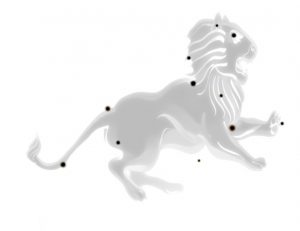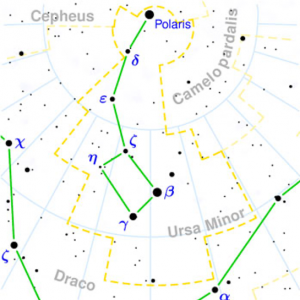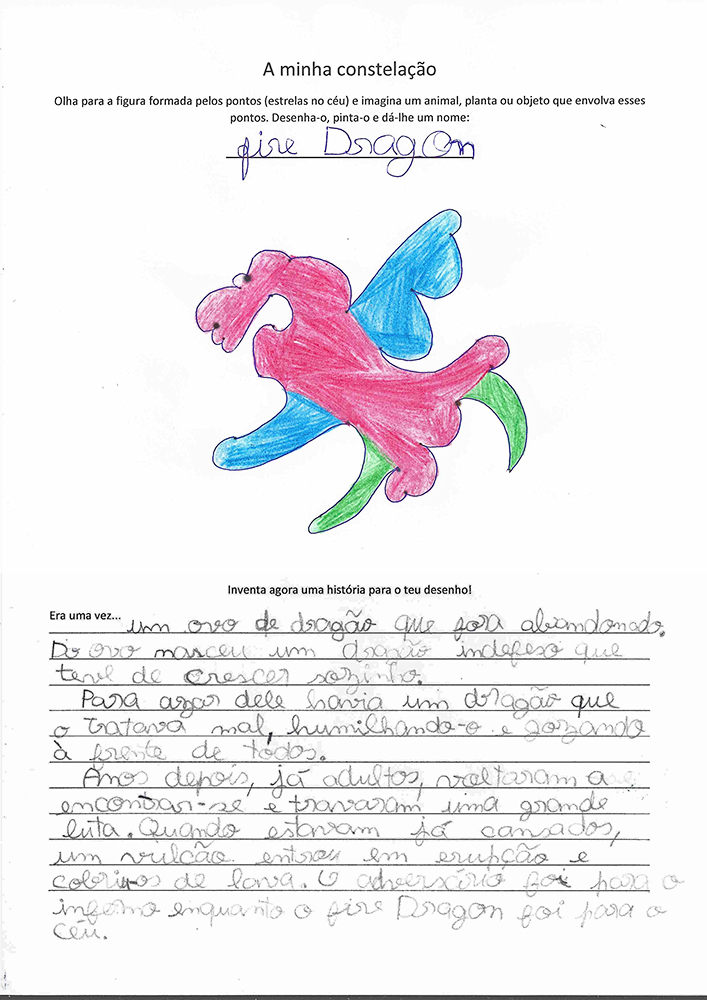A minha constelação

O DESAFIO desta semana é darmos asas à nossa imaginação e criarmos a nossas próprias constelações!
Longe da cidade, numa noite escura, pode-se ver mais de 1000 estrelas espalhadas no céu. Na antiguidade, os homens imaginaram figuras formadas a partir das posições das estrelas e inventaram histórias sobre elas, dando origem às constelações. Esta forma de ficar a conhecer o céu foi muito útil para criar calendários (muito importante para a agricultura, por exemplo) e para navegar sem terra à vista.
Em regiões diferentes surgiram lendas diferentes, muitas vezes associadas a crenças e religiões dos povos. As constelações que surgiram na Grécia antiga foram diferentes das que surgiram na China, na Austrália, ou nas Américas!
Vamos conhecer algumas histórias antigas….
Ursa Menor (Ursa Minor)

Leão (Leo)

As constelações modernas
Hoje em dia, sabemos que as estrelas que nos parecem próximas quando as vemos no céu, podem estar a distâncias monstruosas umas das outras – não existe relação física entre as estrelas da mesma constelação. Desde o início do século passado, os astrónomos dividiram o céu em 88 áreas, sendo cada uma definida como uma constelação. Os nomes das constelações modernas tiveram como base as constelações ocidentais.
Mais algumas histórias… Gémeos Cruzeiro do Sul Orionte
DESAFIO!
Mesmo já sabendo o que são as constelações modernas, podemos viajar até à Antiguidade e criar as nossas próprias constelações!
Partindo dos pontos que representam as estrelas das seguintes constelações, imagina um animal, planta ou objeto que envolva esses pontos – desenha-o, pinta-o e dá-lhe um nome!
A_minha_Ursa_Menor O_meu_Leão O_meu_Cruzeiro_do_Sul O meu Orionte O_meu_Gémeos
Envia-nos o teu trabalho para desafios@nuclio.org e ele figurará na nossa galeria!
Lembra-te de incluir o teu nome, idade, nacionalidade e que os trabalhos deverão ser em formato de imagem JPG ou PNG, com um máximo de 2MB!
Nota: O envio do(s) ficheiro(s) implica a autorização de publicação nesta galeria e nas redes sociais do NUCLIO.
My own constellation

This week, DARE use your imagination and create your own constellations!
Away from the city, on a dark night, you can see more than 1000 stars scattered across the sky. In antiquity, men imagined figures formed from the positions of the stars and invented stories about them, giving rise to the constellations. It helped them to get to know the sky, which was very useful for storytelling, calendars (so important for agriculture), and navigation.
Different legends emerged in different regions, often associated with peoples’ beliefs and religions. The constellations that arose in ancient Greece were different from those that arose in China, Australia, or the Americas!
Let’s get to know some old stories ….
Little Bear (Ursa Minor)

Lion (Leo)

Modern constellations
Nowadays, we know that the stars that seem close to us when we see them in the sky can be at monstrous distances from each other – there is no physical relationship between the stars in the same constellation. Since the beginning of the last century, astronomers have divided the sky into 88 areas, each defined as a constellation. The names of modern constellations were based on western constellations.
More stories… Twins Orion Southern_Cross
DARE DIY!
Even though we already know what modern constellations are, we can travel to antiquity and create our own constellations!
Starting from the points that represent the stars of the following constellations, imagine an animal, plant or object that surrounds these points – draw it, paint it and give it a name!
My_Ursa_Minor My_Twins My_Southern_Cross My_Orion My_Lion
Send us your work to desafios@nuclio.org and it will appear in our gallery!
Remember to include your name, age, and country, and that the files must be in JPG or PNG image format, with a maximum of 2MB!
Note: The sending of the file(s) implies the consent to publish in this gallery and on NUCLIO’s Social Media.
GALERIA de “A minha constelação” – GALLERY of “My own constellation”








Leave a Reply